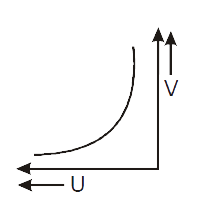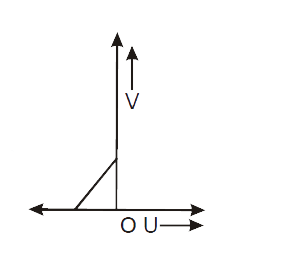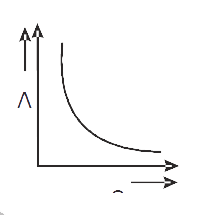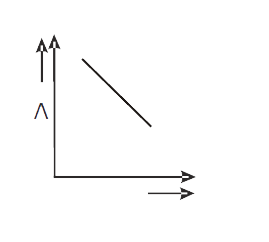Write two characteristics of image formed when an object is placed between the optical centre and focus of a thin convex lens. Draw the graph showing variation of image distance v with object distance u in this case.
To solve the question, we will follow these steps:
Step 1: Identify the characteristics of the image formed by a thin convex lens when the object is placed between the optical center (O) and the focus (F).
1. Virtual Image: The image formed is virtual because the rays of light diverge after passing through the lens, and the image cannot be projected on a screen.
2. Erect Image: The image is erect, meaning it is oriented in the same direction as the object.
3. Enlarged Image: The image is larger than the object, hence it is highly enlarged.
Step 2: Draw the ray diagram for the situation.
1. Draw a thin convex lens with its principal axis.
2. Mark the optical center (O) and the focus (F) on either side of the lens.
3. Place the object (AB) between O and F.
4. Draw two rays from the top of the object:
- One ray parallel to the principal axis, which refracts through the focus on the opposite side.
- Another ray passing through the optical center, which continues in a straight line.
5. Extend these rays backward to locate the position of the virtual image (A'B').
Step 3: Establish the relationship between object distance (u) and image distance (v).
Using the lens formula:
1f=1v−1u
Where:
- f = focal length (positive for a convex lens)
- u = object distance (negative as per sign convention)
- v = image distance (negative for virtual images)
Step 4: Graph the variation of image distance (v) with object distance (u).
1. Plot the graph with object distance (u) on the x-axis and image distance (v) on the y-axis.
2. As the object moves closer to the focus (F), the image distance (v) approaches infinity.
3. When the object is at the optical center (O), the image distance (v) is at its maximum negative value.
Step 5: Label the graph.
1. Mark the points where the object is at the focus (F) and at twice the focal length (2F).
2. Indicate the behavior of the graph as the object approaches the focus, showing that the image distance approaches infinity.
Final Summary of Characteristics:
- Virtual: The image cannot be projected on a screen.
- Erect: The image maintains the same orientation as the object.
- Highly Enlarged: The image size is larger than the object.
2. Erect Image: The image is erect, meaning it is oriented in the same direction as the object.
3. Enlarged Image: The image is larger than the object, hence it is highly enlarged.
2. Mark the optical center (O) and the focus (F) on either side of the lens.
3. Place the object (AB) between O and F.
4. Draw two rays from the top of the object:
- One ray parallel to the principal axis, which refracts through the focus on the opposite side.
- Another ray passing through the optical center, which continues in a straight line.
5. Extend these rays backward to locate the position of the virtual image (A'B').
1f=1v−1u
Where:
- f = focal length (positive for a convex lens)
- u = object distance (negative as per sign convention)
- v = image distance (negative for virtual images)
2. As the object moves closer to the focus (F), the image distance (v) approaches infinity.
3. When the object is at the optical center (O), the image distance (v) is at its maximum negative value.
2. Indicate the behavior of the graph as the object approaches the focus, showing that the image distance approaches infinity.
- Virtual: The image cannot be projected on a screen.
- Erect: The image maintains the same orientation as the object.
- Highly Enlarged: The image size is larger than the object.
Topper's Solved these Questions
- SAMPLE QUESTION PAPER (THEORY)BOOK - CBSE MODEL PAPERCHAPTER - SAMPLE QUESTION PAPER (THEORY)EXERCISE - Section -D
7 Videos
- SAMPLE QUESTION PAPER (THEORY)BOOK - CBSE MODEL PAPERCHAPTER - SAMPLE QUESTION PAPER (THEORY)EXERCISE - Section – E
6 Videos
- SAMPLE QUESTION PAPER (THEORY)BOOK - CBSE MODEL PAPERCHAPTER - SAMPLE QUESTION PAPER (THEORY)EXERCISE - Section – B
10 Videos
- SAMPLE PAPER 2023 TERM IBOOK - CBSE MODEL PAPERCHAPTER - SAMPLE PAPER 2023 TERM IEXERCISE - SECTION D
4 Videos
Similar Questions
Draw a ray diagram to show the formation of the image of an object placed between the optical centre and focus of a convex lens. Deduce the relationship between object distance, image disatnce and focal length of lens.
View SolutionDraw a ray diagram to show the formation of the image of an object placed between the optical centre and principal focus of a convex lens. Deduce the relationship between the object distance, image distance and focal length under the conditions stated.
View Solution
Knowledge Check
If an object is placed at the principal focus of a convex lens, the image formed is real, inverted and
AmagnifiedBdiminishedCof same size as that of objectDhighly magnified.If an object is placed at the principal focus of a convex lens, the image formed is real, inverted and
AmagnifiedBdiminishedCof same size as that of objectDhighly magnified.The graph between the image distance (v ) and object distance (u) from the convex lens is
A B
B C
C D
D
State three characteristics of the image formed by a convex lens when the object is close to it.
View Solution(a) List four characteristics of the image formed by a convex lens when an object is placed between its optical centre and principal focus.
(b) Size of the image of an object by a concave lens of focal length 20 cm is observed to be reduced to 13 rd of its size. Find the distance of the object from the lens.
View SolutionDraw ray diagrams showing the image formation by a concave lens when an object is placed
(a) between focus and twice the focal length of the lens
(b) beyond twice the focal length of the lens
View SolutionDraw a ray diagram in each of the following cases to show the formation of image, when the object is placed :
(i) between optical centre and principal focus of a convex lens.
(ii) anywhere in front of a concave lens.
(iii) at 2F of a convex lens.
State the signs and values of magnifications in the above mentioned cases (i) and (ii).
View SolutionIf an object is placed at the focus of a convex lens, where is the image formed?
View Solution
